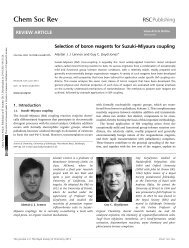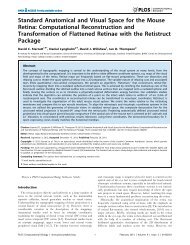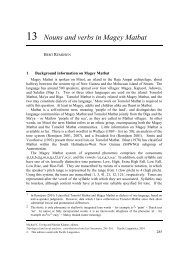Sturgeon fishing in the middle and lower Danube region László ...
Sturgeon fishing in the middle and lower Danube region László ...
Sturgeon fishing in the middle and lower Danube region László ...
You also want an ePaper? Increase the reach of your titles
YUMPU automatically turns print PDFs into web optimized ePapers that Google loves.
<strong>László</strong> Bartosiewicz et al.: <strong>Sturgeon</strong> <strong>fish<strong>in</strong>g</strong> <strong>in</strong> <strong>the</strong> <strong>middle</strong> <strong>and</strong> <strong>lower</strong> <strong>Danube</strong> <strong>region</strong><br />
Table 7. Measurements of sturgeon caught at known seasonal dates <strong>in</strong> <strong>the</strong> Hungarian<br />
section of <strong>the</strong> <strong>Danube</strong>.<br />
Year Date<br />
Location<br />
1957<br />
1922<br />
1950<br />
1936<br />
1927<br />
1987<br />
1957<br />
1954<br />
Mean value, spr<strong>in</strong>g<br />
St<strong>and</strong>ard deviation<br />
W<strong>in</strong>ter<br />
1911<br />
1956<br />
1870<br />
1894<br />
1955<br />
1953<br />
Mean value, spr<strong>in</strong>g<br />
St<strong>and</strong>ard deviation<br />
March 2<br />
March 3<br />
March 8<br />
March 18<br />
‘Good Friday’<br />
May 16<br />
May<br />
May 27<br />
early September<br />
October 6<br />
‘w<strong>in</strong>ter catch’<br />
‘w<strong>in</strong>ter catch’<br />
January 31<br />
February 1<br />
P-value of Student’s t-test<br />
Historical accounts of sturgeon <strong>in</strong> <strong>the</strong> <strong>Danube</strong><br />
While large Acipenserid bones commonly occur <strong>in</strong> some<br />
Mesolithic <strong>and</strong> Neolithic archaeological assemblages, <strong>the</strong>y<br />
seem to become rare by <strong>the</strong> late Middle Ages. In part, this<br />
may be expla<strong>in</strong>ed by a shift <strong>in</strong> <strong>the</strong> focus of archaeological<br />
research: catch sites were more likely to co<strong>in</strong>cide with <strong>the</strong><br />
sites of consumption dur<strong>in</strong>g prehistory. By <strong>the</strong> Middle Ages,<br />
however, sturgeon rema<strong>in</strong>s are best known from high status<br />
settlements <strong>in</strong> <strong>the</strong> <strong>Danube</strong> Bend gorge <strong>in</strong> Hungary (Fig. 8).<br />
This valuable fish is known to have been traded over both<br />
short <strong>and</strong> long distances. From an archaeological po<strong>in</strong>t of<br />
view, however, most relevant historical <strong>in</strong>formation relates to<br />
methods of catch<strong>in</strong>g <strong>the</strong>se animals. Given <strong>the</strong> large size of<br />
beluga sturgeon especially, l<strong>and</strong><strong>in</strong>g it posed a special challenge<br />
to fisherfolk <strong>in</strong> all periods. Accord<strong>in</strong>g to Masen (1681:<br />
898), “<strong>the</strong> beluga is similar to sturgeon <strong>and</strong> as strong as a<br />
tuna, frequent <strong>in</strong> <strong>the</strong> <strong>Danube</strong>”. While <strong>the</strong>re is no direct evidence<br />
of prehistoric sturgeon <strong>fish<strong>in</strong>g</strong> techniques along <strong>the</strong><br />
<strong>Danube</strong>, elaborate systems for sturgeon <strong>fish<strong>in</strong>g</strong> have been<br />
documented s<strong>in</strong>ce <strong>the</strong> Middle Ages.<br />
<strong>Sturgeon</strong> weirs<br />
In accordance with <strong>the</strong> large size <strong>and</strong> strength of <strong>the</strong>se animals,<br />
traps or enclosures placed <strong>in</strong> rivers to catch sturgeon, often<br />
<strong>in</strong>cluded massive timber structures, sometimes <strong>in</strong> comb<strong>in</strong>ation<br />
with large-holed nett<strong>in</strong>g. The placement of weirs<br />
was of strategic importance. Familiarity with sturgeon habitats,<br />
i.e. features of riverbed <strong>and</strong> adjacent topography, as well<br />
as <strong>the</strong> knowledge of sturgeon behaviour were, thus, <strong>in</strong>strumental<br />
<strong>in</strong> m<strong>in</strong>imiz<strong>in</strong>g labour expenditure required for <strong>the</strong><br />
construction of weirs.<br />
The German naturalist Johann Georg Gmel<strong>in</strong> became a<br />
professor of chemistry <strong>and</strong> natural sciences <strong>in</strong> St. Petersburg,<br />
Russia <strong>in</strong> 1731. He documented a sturgeon weir shaped like<br />
Paks<br />
Gemenc<br />
Százhalombatta<br />
Dunapataj<br />
Dunapentele<br />
Paks<br />
Baja<br />
Paks<br />
Orsova (Iron Gates)<br />
Ercsi<br />
Ásvány-Győr<br />
Pozsony<br />
Ercsi<br />
Ercsi<br />
49<br />
Weight (kg)<br />
138<br />
90<br />
132<br />
63<br />
86<br />
181<br />
134<br />
50<br />
109.3<br />
44.2<br />
102<br />
117<br />
250<br />
100<br />
117<br />
63<br />
109.3<br />
44.2<br />
Length (cm)<br />
273<br />
220<br />
300<br />
215<br />
235<br />
300<br />
280<br />
203<br />
253.3<br />
39.5<br />
252<br />
263<br />
365<br />
200<br />
263<br />
213<br />
253.3<br />
39.5<br />
0.600 0.819<br />
a maze <strong>and</strong> made from timber fenc<strong>in</strong>g which stretched across<br />
<strong>the</strong> Volga river. <strong>Sturgeon</strong>s swimm<strong>in</strong>g upstream were trapped<br />
<strong>in</strong> <strong>the</strong> four, curvaceous ‘pockets’ of this complex structure<br />
(Kh<strong>in</strong> 1957: 12, fig. 7).<br />
N<strong>in</strong>eteenth century sturgeon traps <strong>in</strong> <strong>the</strong> Iron Gates gorge<br />
were described by Jókai (1872: 7) as follows: “Between <strong>the</strong><br />
islets, <strong>the</strong> narrow branches of <strong>the</strong> <strong>Danube</strong> are disrupted [by]<br />
double post structures made from robust timber, arranged <strong>in</strong><br />
a V-shape, open<strong>in</strong>g downstream... Once <strong>the</strong> sturgeons enter, it<br />
is not <strong>the</strong>ir habit to turn downstream. As <strong>the</strong>y proceed <strong>in</strong> <strong>the</strong><br />
ever-narrow<strong>in</strong>g funnel, <strong>the</strong>y w<strong>in</strong>d up <strong>in</strong> <strong>the</strong> ‘death chamber’<br />
at <strong>the</strong> end...”.<br />
Mixed-media weirs <strong>in</strong>cluded <strong>the</strong> use of strong nets as well.<br />
Kh<strong>in</strong> (1957: 14–15) refers to a 16th century description by<br />
Miklós Oláh. Wooden posts were staked across <strong>the</strong> <strong>Danube</strong> <strong>in</strong><br />
November, before <strong>the</strong> waters grew icy. Fishermen <strong>in</strong> boats<br />
stretched nets between <strong>the</strong> evenly placed posts, <strong>the</strong>n cannons<br />
were fired to scare sturgeons <strong>in</strong>to <strong>the</strong> traps.<br />
Medieval documents suggest that full closure of rivers<br />
would have been considered an unfriendly or even illegal<br />
move. A 1528 court case <strong>in</strong> Hungary between <strong>the</strong> city of Vác<br />
<strong>and</strong> <strong>the</strong> royal capital, Buda (located downstream), clearly<br />
shows <strong>the</strong> compet<strong>in</strong>g <strong>in</strong>terests of <strong>the</strong>ir sturgeon <strong>fish<strong>in</strong>g</strong> communities<br />
(Szilágyi 1995: 114). Weirs, <strong>the</strong>refore, were often<br />
placed between <strong>the</strong> bank <strong>and</strong> smaller islets, thus, exploit<strong>in</strong>g<br />
only one of <strong>the</strong> river’s branches.<br />
One of <strong>the</strong> most <strong>in</strong>structive documents on sturgeon <strong>fish<strong>in</strong>g</strong><br />
<strong>in</strong> <strong>the</strong> Iron Gates gorge is found <strong>in</strong> Volume IV of Marsigli’s<br />
1726 work. The frontispiece (Fig. 12) portrays numerous<br />
technical details. It shows a tunnel of three A-shaped gates<br />
built between a small isl<strong>and</strong> <strong>and</strong> <strong>the</strong> right bank of <strong>the</strong> <strong>Danube</strong><br />
(an arrow clearly <strong>in</strong>dicates <strong>the</strong> downstream direction). In <strong>the</strong><br />
<strong>lower</strong> half of <strong>the</strong> picture <strong>the</strong> narrow gorge is flanked by steep,<br />
misty cliffs. Dense ripples <strong>in</strong>dicate a more rapid current here.<br />
<strong>Sturgeon</strong> are be<strong>in</strong>g caught at <strong>the</strong> downstream end of this sec-









